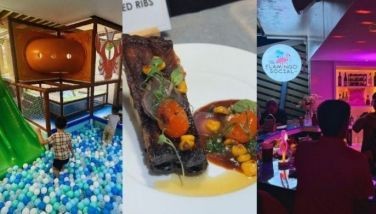Design wonders of the West Coast
February 24, 2007 | 12:00am
 I went to the States recently on an unplanned architectural pilgrimage. Three weeks were not enough to see the whole USA, so we chose to see only two states  California and Nevada.
I went to the States recently on an unplanned architectural pilgrimage. Three weeks were not enough to see the whole USA, so we chose to see only two states  California and Nevada.
The last time I was in the States was two years ago, after I had just graduated from architecture school. Back then, I didn’t have anything else in mind but to relax and have a great vacation. This time was different because even before I left, I psyched myself up to observe and absorb all the architectural marvels that I could possibly see.
My first stop was the Getty Center by Richard Meier, which is a renowned piece of architectural design. I met up with a friend who was gracious enough to accompany me to the museum. We took the San Diego freeway and when I saw a cluster of stark, white buildings on top of a hill, I knew that was it. From a centralized parking area, we were taken to the top of the hill by a computer-operated tram. We then arrived at a central arrival plaza, from which you can see the whole symphony of Meier’s travertine and aluminum buildings while enjoying breathtaking panoramic views of the city.
The Getty Center is comprised of the Getty Conservation Institute, the Getty Education Institute for the Arts, the Getty Grant Program, the Getty Information Institute, the J. Paul Getty Trust, the Getty Research Institute for the History of Art and the Humanities, the J. Paul Getty Museum, an auditorium, a central garden, and several cafes and restaurants. All these buildings are organized along a natural ridge on the hilltop and around a series of courtyards and terraces. All the structures are no more than two stories high, complementing the natural contours of the landscape. The need for space was answered by extending the buildings underground and linking them with subterranean corridors that facilitate the moving of artwork and other materials.
The buildings are organized by a perfectly oriented north-south grid with a three-foot-by-three-foot module, which clearly expresses the cubist beliefs of Meier.
One of the most remarkable elements of the complex is the travertine stone that was used to clad most of the buildings: 16,000 tons of stone were quarried from Tivoli, Italy, 15 miles east of Rome. They claim that this is the same kind of stone the Romans used to build the Colosseum. To make the complex different, Meier and his staff worked for a year with the quarries to invent a process using guillotine to produce a unique finish.
Meier has also been known for his expert use of natural light. The many exterior walls of glass allow sunshine to illuminate the interiors. A computer-assisted system of louvers and shades adjusts the light indoors. The galleries of paintings on the museum’s upper level are all naturally lit, with special filters to prevent damage to the artworks.
To me, The Getty is certainly one of the best-designed museums in the world, with its interior ambience that is perfect for the appreciation of art, its layout which allows an efficient flow of visitors, and the placement of buildings which creates exterior public spaces that blend seamlessly with the landscape.
My next destination was Diamond Ranch High school in Diamond Bar, California. Even though it was out of the way, I insisted on seeing it because I had read about this architectural masterpiece. The school was designed by Morphosis, headed by Thom Mayne, who just recently won the Pritzker Prize in 2005 for his architectural works. At first I thought that it was impossible for the architect to design a 72-acre campus on a series of cascading hills, but when I saw the first clusters of buildings, all my doubts disappeared. The site is divided into three zones. On top of the hills are football fields, on the bottom are soccer fields and tennis courts. Sandwiched in between are two rows of buildings with a pedestrian street running down the middle. The rows are divided into clusters, each of which has its own set of classrooms separated according to discipline, as well as its own courtyard.
Students, faculty, and administration can move freely between clusters. The crisscrossing has the effect of splitting the building lines into smaller fragments. This breaking up of the linear mass into functional units also gives the effect of creating various types and sizes of communal spaces.
What impressed me the most aside from the layout is the physical appearance of the structures. I entered the school at the east end and was engulfed by a series of distorted roof geometries overhead. The corrugated steel panels fold, twist, and bend, taking on the forms of nearby mountains. The two sets of structures flanking the street seem to reach out to each other, angled precariously in such a way that I thought that they could tip over anytime. Collectively, the design of the structures creates a new kind of horizon that seems to mimic the mountains nearby.
From California, we drove down to Las Vegas. I have been there before but the Strip still excited me, because aside from the fact that money is no object in terms of the design of the structures, it was like going on a trip around the world! One minute you feel like you’re in Europe, then all of a sudden you’re transported to Egypt. That’s because all their hotels have different architectural themes. To name a few: Caesar’s Palace is based on the architecture of Rome. Carribean Island’s design is taken from the culture of ships, sails, and pirates! New York, New York’s architecture is based on the city’s iconic buildings. It is actually just one structure, but if you look at it from the outside, it’s designed in such a way that you’ll think it’s a cluster of 13 different New York landmarks such as the Chrysler and Empire State buildings. There is also a huge replica of the Statue of Liberty right at the corner of the hotel.
Right across it is Excalibur, a hotel that looks like a huge fantasy castle in England that you only read about in the stories of King Arthur and his knights. You might even see Sir Lancelot or Guinevere walking around the lobby because hotel employees are dressed like knights with swords and maidens in ponytails.
Egypt’s presence in the Vegas strip may be seen through the Luxor Hotel, which is designed like the monumental pyramids that are only seen in Giza, complete with the avenue of sphinxes. What makes it fascinating is that instead of using stone to build it, they used black glass to clad the whole pyramid. The tip of the pyramid projects a beam of light shooting straight to the sky at night, creating a dramatic presence for the hotel, which can be seen even if you are miles away from the Strip.
I have never been to Europe, and that is why the last two hotels on my list are my favorite ones  the Paris and the Venetian. I can spend one whole day just looking at how marvelous the designs of both hotels are, thanks to the intricate details of the colonnades, moldings and pediments, among other elements. If you spend time going around the lobby, you won’t know whether it’s day or night outside because the ceiling is painted to look like the blue afternoon sky, so you’ll always think that it’s a beautiful day!
In the Paris hotel there is a monumental replica of the Eiffel Tower, every architect’s must-see. It looks so close to the real thing that the picture of myself with the replica in the background can easily be used to fool my friends that I’ve actually been to Paris.
Venice is a beautiful city built around canals and creeks, famous for its love boats that you can ride as the boatman serenades you while maneuvering the boat. You can have the same experience at the Venetian for five dollars because they have their own canal that goes around the lobby. So if you’re planning to propose to your girlfriend in Venice but don’t have the budget, a trip to the Venetian will do.
The next day we drove to Hoover Dam. I couldn’t help wondering how much they spent constructing this gigantic feat of engineering. It is one of the most breathtaking man-made structures I have ever seen. It was the first man-made structure to exceed the masonry mass of the pyramids in Egypt. There was enough concrete used to build a four-foot wide sidewalk around the earth’s equator. Construction started in 1931, three years after Secretary of Commerce Herbert Hoover proposed the idea of building what was then called Boulder Dam, dividing the river into an upper and a lower basin. Seven states were disputing how much of the river each could claim, and this was a first step towards a solution. It was the largest single contract awarded at that time by the federal government.
According to the video presentation that was part of the tour, it took the resources of six companies forged into one entity to undertake the mammoth project. There were 3,500 workers a day who worked three shifts, seven days a week, earning four dollars a day. It was finished in 1935 and since then has been providing flood control, water supply, and electrical power to millions of homes in California and southwest Arizona. Amazing!
This trip made me see more clearly that architecture and engineering can contribute a great deal to the beauty and value of a place. It can be used to construct places of culture, like the Getty, where people fully appreciate different artistic endeavors. In Diamond Ranch High School, architecture was used to create more efficient educational experiences through constant interaction with colleagues, ushering in the free exchange of ideas. Architecture is also an essential tool in entertainment and recreation. In Las Vegas it was used to replicate different structures from around the world, giving the visitor the illusion of actually being in those places. It can also serve practical, functional, and humanitarian uses, as it did in the Hoover Dam, which became responsible for the quality of life that millions now enjoy. This trip made me realize that architects should not be content with only the aesthetic aspect of the profession  it is our responsibility to ensure that every piece of architecture we produce has a positive impact on humanity.
BrandSpace Articles
<
>




















